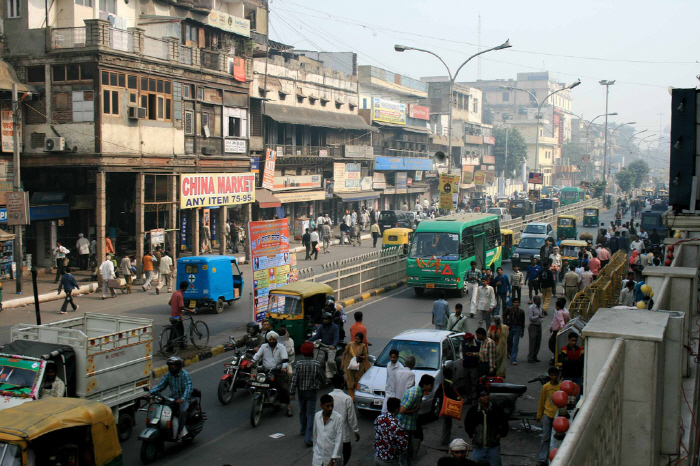It was a move that could have brought India’s economy to a shuddering halt. Indeed, the seemingly endless queues outside banks, and the difficulty of spending cash at shops and stalls may have seemed like it did. But the decision to demonetise the 500 and 1,000 rupee notes was just one in a series of moves that will push India towards a digital economy.
The demonetisation was implemented with the aim of eliminating societal corruption and counterfeit currency. But the move was sudden, happening overnight. The two notes accounted for 86% of the bank notes in circulation in India, and retailers and consumers were forced to look immediately for options. Many turned to digital paying systems.
The digital money strategy has been laid out by Prime Minister Modi’s government from its early days in power, via a string of major decisions. The Jan Dhan scheme, for example, saw more 220m new bank accounts being opened for the poorest in society. The Reserve Bank of India also decommissioned all currency notes issued before 2005.
Until recently, cash was used for more than two-thirds of transactions in India. However, just over a month into the demonetisation and the country had already started to see the benefits of digital transactions. Government figures show a 268% increase in year-on-year tax collection from 47 Indian cities for November 2016.
But can India become a truly cashless society? These moves are pushing the economy in the right direction, but is it digitally savvy enough for such a system to survive?
Digital money
Since the removal of the notes, the government has been working hard to promote digital payment systems to consumers, proactively offering different incentives and rewards. So far, it seems to be working: the government has reported a 400-1,000% increase in digital transactions since the demonetisation.
Go digital, get benefits. pic.twitter.com/sSMOuhFSlt
— Narendra Modi (@narendramodi) December 9, 2016
The changes have created perfect market conditions for alternative digital payment systems, in addition to existing e-wallets and debit/credit cards. These are not just the basic banking apps or websites either. The National Payments Corporation of India, together with the RBI, has launched UPI (“united payment interface”), which powers multiple accounts from participating banks, and offers several banking services all in a single mobile application.
A step in the right direction certainly, but not one without its problems. Although India has around 220m smartphone users as of February 2016, there is still a long way to go until 100% of the population has mobile internet access.
Nevertheless, the banks have made sure that smartphone ownership is not a barrier to accessing mobile payments, providing a USSD option on older, “non-smart” phones which users call up for. In addition, the “Digital India Initiative” has been set up to provide internet access and comprehensive mobile phone coverage across India, helping over a billion people to get online and utilise digital payment techniques.
Furthermore, the RBI has been promoting a biometric authentication system for banking. The Aadhar Enabled Payment System (AEPS) can be used to open a bank account, withdraw or deposit cash, and transfer funds using just an identification number and fingerprint.
AEPS was created to serve remote towns and villages where cash machines cannot be provided. It has the potential to be the cornerstone of the government’s vision of a cashless digital society – if it can penetrate deeply enough into rural India.
India’s adoption
The people of India are the biggest hurdle in the implementation of the cashless strategy. By and large, they have welcomed the beginnings of a cashless society, albeit with some opposition to the demonetisation implementation. Many can already see the benefits of going cash-free – such as the ability to tender exact change at small retailers, and keep track of expenditures – and are ready to adopt.
The opportunity is there, and the Indian authorities are certainly keen to take it. The interdepartmental approach by the government, working on finance, internet penetration and public relations strategies all at once is essential to making the cashless plan work. Overseen by the government’s Niti Ayog (planning commission), the plan is to implement these systems in the shortest amount of time possible.
But citizens have to feel confident about the move, especially those who doubt online security. Furthermore, the cashless initiative needs comprehensive pan-India awareness, especially in more rural areas. Participation by rural and cooperative banks, post offices and other financial institutions to create awareness and education programmes will ultimately pave the way for a cashless economy.
Training will be a necessity in urban parts of the country, too. Awareness is all well and good, but some will still need help to understand how to install and use digital payment systems.
Although it would be impossible for India to become a cashless economy in the short amount of time since demonetisation, it is definitely something the country can look forward to. Making India cashless is like treating multiple chronic societal diseases using just one cure. Demonetisation was just the first step and now much more needs to be done – but the country can get there.
 Yogesh K Dwivedi has developed and co-authored this article with Dr G.P. Sahu, Mukunda Murthi Rao and Ankita Chandra from Motilal Nehru National Institute of Technology Allahabad, UP, India.
Yogesh K Dwivedi has developed and co-authored this article with Dr G.P. Sahu, Mukunda Murthi Rao and Ankita Chandra from Motilal Nehru National Institute of Technology Allahabad, UP, India.
This article was originally published on The Conversation. Read the original article.



 RBA Unlikely to Cut Interest Rates in 2026 as Inflation Pressures Persist, Says Westpac
RBA Unlikely to Cut Interest Rates in 2026 as Inflation Pressures Persist, Says Westpac  Trump Defends Economic Record in North Carolina as Midterm Election Pressure Mounts
Trump Defends Economic Record in North Carolina as Midterm Election Pressure Mounts  Asian Fund Managers Turn More Optimistic on Growth but Curb Equity Return Expectations: BofA Survey
Asian Fund Managers Turn More Optimistic on Growth but Curb Equity Return Expectations: BofA Survey  BOJ Poised for Historic Rate Hike as Japan Signals Shift Toward Monetary Normalization
BOJ Poised for Historic Rate Hike as Japan Signals Shift Toward Monetary Normalization  Austan Goolsbee Signals Potential for More Fed Rate Cuts as Inflation Shows Improvement
Austan Goolsbee Signals Potential for More Fed Rate Cuts as Inflation Shows Improvement  EU Delays Mercosur Free Trade Agreement Signing Amid Ukraine War Funding Talks
EU Delays Mercosur Free Trade Agreement Signing Amid Ukraine War Funding Talks  BoE Set to Cut Rates as UK Inflation Slows, but Further Easing Likely Limited
BoE Set to Cut Rates as UK Inflation Slows, but Further Easing Likely Limited  U.S. Stock Futures Slip After CPI-Fueled Rally as Markets Weigh Economic Uncertainty
U.S. Stock Futures Slip After CPI-Fueled Rally as Markets Weigh Economic Uncertainty  Fed Near Neutral Signals Caution Ahead, Shifting Focus to Fixed Income in 2026
Fed Near Neutral Signals Caution Ahead, Shifting Focus to Fixed Income in 2026  U.S. Stock Futures Edge Higher as Micron Earnings Boost AI Sentiment Ahead of CPI Data
U.S. Stock Futures Edge Higher as Micron Earnings Boost AI Sentiment Ahead of CPI Data  Precious Metals Rally as Silver and Platinum Outperform on Rate Cut Bets
Precious Metals Rally as Silver and Platinum Outperform on Rate Cut Bets 
































